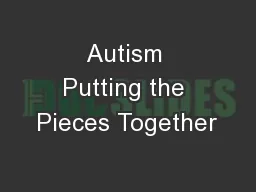

Visual Structure Definition The process of incorporating concrete visual cues into a task or activity Purpose To capitalize on visual strengths while minimizing reliance on weaker auditory processing skills ID: 659176
Download Presentation The PPT/PDF document "Autism Putting the Pieces Together" is the property of its rightful owner. Permission is granted to download and print the materials on this web site for personal, non-commercial use only, and to display it on your personal computer provided you do not modify the materials and that you retain all copyright notices contained in the materials. By downloading content from our website, you accept the terms of this agreement.
Slide1
Autism
Putting the Pieces TogetherSlide2
Visual Structure
Definition: The process of incorporating concrete visual cues into a task or activity.
Purpose: To capitalize on visual strengths, while minimizing reliance on weaker auditory processing skills.Slide3
Proactive Strategies 101
Prevention: In order for behavior problems to be minimized, there is the need for a repertoire of PREVENTION, INTERVENTION, and POST-VENTION strategies. If there is a piece missing, do some fine-tuning and tweaking to find out what is the missing puzzle piece.Slide4
Three Key Elements
Visual Instructions
Visual Organization
Visual ClaritySlide5
Visual Instructions
Visually tells the student the sequence to complete the task
Visual instruction helps the child to combine and organize a series of elements to obtain a desired outcomeSlide6
Levels of Visual Instruction
Jig / Cutout / Inset Puzzle / Task Boxes
One to one correspondence / objects
The student matches the same colored blocks in a predetermined pattern.
The student demonstrates one-to-one correspondence by placing one cotton ball in each spot in an ice cube tray.Slide7
Levels of Visual Instruction
Pictures
Picture list – shows correct sequence to complete task
The student sequences letters of the alphabet.Slide8
Levels of Visual Instruction
Picture Dictionary
Pictures paired with the written word
This helps introduce beginning reading skillsSlide9
Levels of Visual Instruction
Written Instructions
Single words or multiple word sequences that tell the student what to doSlide10
Levels of Visual Instruction
Product Samples
A previously prepared example of the finished productSlide11
Helps with sensory input by organizing materials and space in the work environment making it easier to understand the task
Visual Organization
Use of physical boundaries, containers, foldersSlide12
Visual Organization
Visual Instructions
Designated work areas
Seated at the front of the class or closest to where teacher stands or sits
Minimize the transitions
Watch out for halls
A place for cooling offSlide13
Visual Organization
Containers & Folders
Separate containers helps reduce distraction
Visually coded
Green
&
Red
for
Go
&
Stop
Left to right
Top to bottom
First and then
Color designated for specific student or subject
Label classroom / areas to correspond to student or subject
PicturesSlide14
Visual Clarity
Visually highlighting the important information
Use visual cues to reinforce any information you need to convey by using colors, pictures, symbols, drawings, grading rubrics, Venn diagrams, numbers, words, or any combination of the above
Visual clarity is achieved by limiting material
Keep it simple
Remove unnecessary or irrelevant materialsSlide15
Visual Schedules
The purpose of a visual schedule is:
Help address the child’s difficulty with sequential memory and organization of time
Assist children with language comprehension problems to understand what is expected of them
To prepare the student for upcoming activities
To assist the student in transitioning independently between activities and environments
Lessen the anxiety level of children with autismSlide16
Visual SchedulesSlide17
Visual Schedules
May include:
Schedule of individual tasks
Schedule of class time
Schedule of the whole day
Activities for a field trip or special event
Visual calendarSlide18
Choosing the Type of Visual Schedule
Real Objects
Photographs (“Picture This”, digital photos)
Realistic drawings
Commercial picture system (Boardmaker)
Written words/lists (agendas)
***Consider at what cognitive level
your student is functioning.***Slide19Slide20Slide21Slide22
30 Reasons to Use and to Keep Using a Visual Schedule
See HandoutSlide23
Resources
Web Sites
Kansas State Resources and Autism Information Websites
Kansas State Resources:
http://www.nichcy.org/stateshe/ks.htm
NICHCY Connections…to Autism Resources:
http://www.nichcy.org/resources/autism.asp
NICHCY Connections…to Asperger Syndrome:
http://www.nichcy.org/resources/asperger.asp
NICHCY Connections…to Rett Syndrome:
http://www.nichcy.org/resources/rett.asp
NICHCY Connections…to Childhood Disintegrative Disorder:
http://www.nichcy.org/resources/disintegrative.asp
NICHCY Connections…to PDDNOS:
http://www.nichcy.org/resources/pddnos.asp
Slide24
Resources
Web Sites
Autism Information Websites
Textol…inexpensive velcro by bulk
http://www.textol.com
Autism Papers…strategies for supporting students with autism
http://www.specialed.us/autism/structure/str11.htm
CESA7 Special Education Services
http://www.cesa7.k12.wi.us/sped/autism/index1.htm
Do 2 Learn
http://www.do2learn.com/picturecards/forms/index.htm
http://www.trainland.tripod.com/pecs.htm
http://www.angelfire.comSlide25
Resources
Web Sites
Autism Information Websites
Beyond Autism
http://trainland.tripod.com/pecs.htm
Books
How Do I Teach this Kid?
Kimberly A. Henry
Practical Strategies for Working with Students with Asperger Syndrome and High-Functioning Autism
Kathy Morris Slide26
Questions
What do I need to explain better or is there a question related to your student?Slide27
Make a Visual Schedule